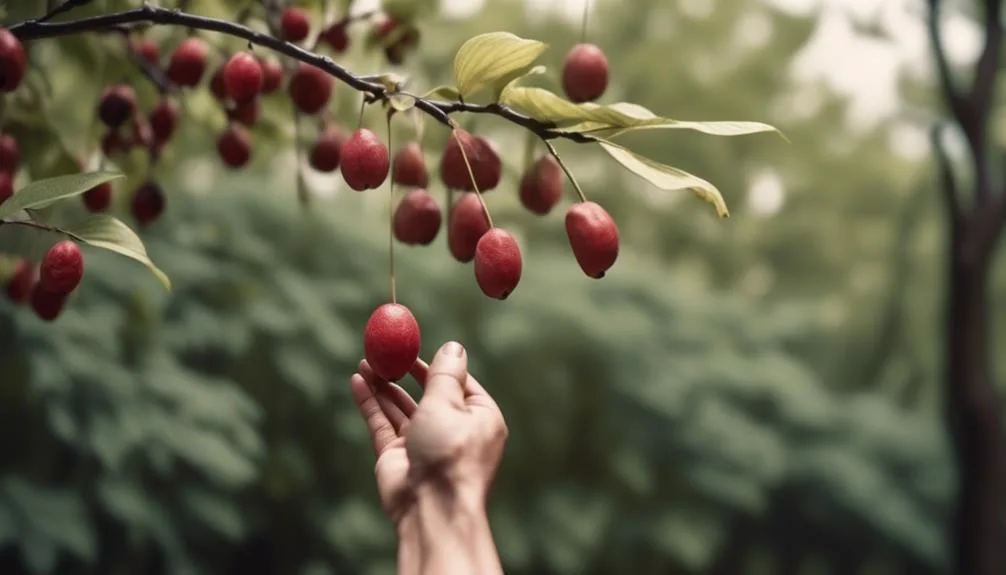You've come across a dogwood tree with its bright red or orange berries, also known as dogwood fruit. Are these berries safe to eat?
Dogwood fruit is a topic with a long history and some debate. Before deciding whether to eat it, it's important to understand more about dogwood fruit, including its nutritional value and any potential risks.
Let's explore the edibility of dogwood fruit together.
Dogwood Fruit Identification
Identifying edible dogwood fruit can be achieved by examining the physical characteristics, such as color, size, and texture, of the fruit. Dogwood fruit typically ranges in color from bright red to dark purple when fully ripe. The size can vary, but they're usually around the size of a cherry. The texture of the fruit is smooth, and when ripe, it's slightly soft to the touch.
When foraging for dogwood fruit, it's important to note these features to ensure you're picking the right ones.
Additionally, understanding the different dogwood fruit recipes can be helpful in determining the best way to use the fruit once it has been identified. Whether it's making jams, jellies, or adding them to baked goods, dogwood fruit can be a versatile and delicious addition to your culinary repertoire.
Edibility of Dogwood Fruit
Once you have identified the physical characteristics of dogwood fruit, it's essential to understand its edibility before incorporating it into your culinary endeavors.
Dogwood fruit is edible and has various culinary uses. The ripe fruit can be consumed fresh, made into jams, jellies, and syrups, or even dried for snacking.
However, it's important to note that while the flesh of the fruit is edible, the seeds and skin should be avoided due to their high levels of oxalic acid, which can cause discomfort if ingested in large quantities.
When consumed in moderation, dogwood fruit offers health benefits such as being rich in antioxidants, vitamins A and C, and fiber. Its tart flavor adds a unique twist to dishes and its potential health benefits make it a valuable addition to your diet when used appropriately.
Nutritional Value of Dogwood Fruit
To understand the nutritional value of dogwood fruit, examine its composition and health benefits to appreciate its potential impact on your diet and well-being.
- Rich in Nutrients: Dogwood fruit is packed with essential nutrients like vitamin C, fiber, antioxidants, and minerals, making it a valuable addition to a balanced diet.
- Potential Health Benefits: Studies suggest that dogwood fruit may have anti-inflammatory and immune-boosting properties, as well as potential benefits for heart health and digestion.
- Versatile in Recipes: Incorporating dogwood fruit into your diet can be enjoyable and versatile. From jams and jellies to baked goods and smoothies, there are numerous delicious ways to include this nutritious fruit in your meals.
With its nutrient-rich profile and potential health benefits, adding dogwood fruit to your diet can be a tasty and beneficial choice. Experiment with dogwood fruit recipes to enjoy its flavors while reaping its health benefits.
Precautions When Eating Dogwood Fruit
After exploring the nutritional value and potential health benefits of dogwood fruit, it's crucial to be aware of certain precautions when incorporating it into your diet to ensure a positive and safe experience.
While dogwood fruit is generally safe for consumption, there are potential risks to consider. Some individuals may be allergic to dogwood fruit, experiencing symptoms such as itching, swelling, or difficulty breathing. If you have a known allergy to similar fruits, such as cherries or apples, it's essential to exercise caution when trying dogwood fruit.
Additionally, consuming unripe dogwood fruit may lead to stomach discomfort due to its high tannin content. To minimize the risk of adverse reactions, always ensure that the fruit is fully ripe before consumption.
Summary: Is Dogwood Fruit Edible?
Dogwood fruit is edible and can be enjoyed as part of a varied and nutritious diet. It offers a unique flavor and can be used in various culinary applications. Here are three reasons why you might want to consider incorporating dogwood fruit into your diet:
- Nutritional Benefits: Dogwood fruit is rich in vitamins, antioxidants, and fiber, making it a healthy addition to your meals.
- Culinary Versatility: You can use dogwood fruit in a variety of recipes, including jams, jellies, syrups, and baked goods, adding a delightful tangy flavor.
- Folklore and Tradition: Dogwood fruit has a rich history in folklore and traditional medicine, making it a fascinating ingredient to explore and incorporate into your culinary repertoire.
Exploring dogwood fruit recipes and learning about its folklore can add an exciting dimension to your culinary adventures.
Conclusion
Incorporating dogwood fruit in moderation can provide a nutritious boost to your diet, thanks to its high antioxidant content and essential vitamins and minerals.
While enjoying its unique flavor, be cautious of potential allergic reactions.
How can we savor the health benefits of this fruit while minimizing risks?

My interest in trees started when I first saw the giant sequoias in Yosemite.
I was a teenager then, and I remember thinking, “I need to learn more about this.”
That moment stuck with me.
A few years later, I went on to study forestry at Michigan Tech.
Since graduating, I’ve worked in a mix of hands-on tree care and community education.
I’ve spent over ten years helping people understand how to plant, maintain, and protect the trees in their neighborhoods.
I don’t see trees as just part of the landscape.
They are living things that make a real difference in our daily lives.
